- Generality
- Reagent Availability
- Experimetal User Friendliness
- Historical Significance
- Criteria #5
-
General Characteristics
In the presence of a metal alkylidene catalyst, two olefins combine and redistribute their fragments to give a new pair of olefins. Olefin metathesis is fundamentally an equilibrium process, therefore a driving force is necessary (such as the removal of ethylene gas out of the system) to push it to the product side of the equation.
-
History
Entering 1990’s, Grubbs reported successful development of active and practical catalysts. Olefin metathesis then quickly became one of the most frequently used reactions in organic synthesis.
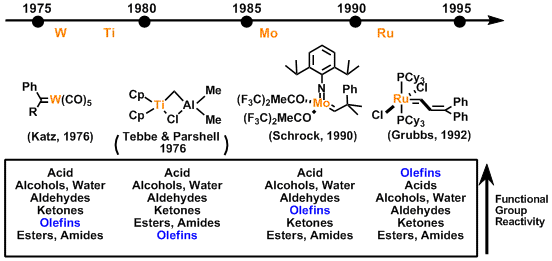
Many laboratories have developed improved versions of the catalyst ever since, some of which are shown below. The molybdenum based Schrock catalyst is extremely active, but somewhat difficult to handle due to its unstability towards air, water, and acid. The Grubbs first and second generation catalysts, which are based on ruthenium-benzylidene, are more user-friendly as they have great functional group tolerance and are easy to handle. However, the Grubbs catalysts are generally less reactive than the Schrock catalyst and difficult to be used for the synthesis of structures like tetrasubstituted olefins.
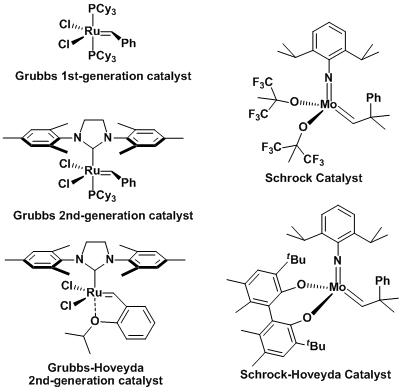
The emergence of olefin metathesis has had immeasurable impact across diverse fields. The Nobel Prize in Chemistry in 2005 was awarded to Grubbs, Schrock, and Y. Chauvin for their contributions to the development of this new catalytic technology.
-
General References
<Early References>
・Calderon, N.; Chen, H. Y.; Scott, K. W. Tetrahedron Lett. 1967, 8, 3327. DOI:10.1016/S0040-4039(01)89881-6
・Calderon, N. Acc. Chem. Res. 1972, 5, 127. DOI: 10.1021/ar50052a002
<Reviews>
・Tetrahedron Symposia: Tetrahedron 1999, 55, 8141-8162. [link]
・Fürstner, A. Angew. Chem. Int. Ed. 2000, 39, 3012. [Abstract]
・Trnka, T. M.; Grubbs, R. H. Acc Chem. Res. 2001, 34, 18. DOI: 10.1021/ar000114f
・片山博之, 小澤文幸, 有機合成化学協会誌 2001, 59, 40.
・Vernall, A. J.; Abell, A. D. Aldrichimica acta 2003, 36, 93. [PDF]
・Connon, S. J.; Blechert, S. Angew. Chem. Int. Ed. 2003, 42, 1900. doi:10.1002/anie.200200556
・Schrock, R. R.; Hoveyda, A. H. Angew. Chem. Int. Ed. 2003, 42, 4592. doi:10.1002/anie.200300576
・McReynolds, M. D.; Dougherty, J. M.; Hanson, P. R. Chem. Rev. 2004, 104, 2239. DOI: 10.1021/cr020109k
・Grubbs, R. H. Tetrahedron 2004, 60, 7117. doi:10.1016/j.tet.2004.05.124
・森美和子, 有機合成化学協会誌 2005, 63, 423.
・Nicolaou, K. C. et al. Angew. Chem. Int. Ed. 2005, 44, 4490. DOI:10.1002/anie.200500369
・Flynn, D. L.; Hanson, P. R. et al. Aldrichimica acta 2005, 38, 3. [PDF]
・Donohoe, T. J.; Orr, A. J.; Bingham, M. Angew. Chem. Int. Ed. 2006, 45, 2664. doi:10.1002/anie.200503512
・Shrodi, Y.; Pederson, R. L. Aldrichimica acta 2007, 40, 45. [PDF]
・Hoveyda, A. H.; Zhugralin, A. R. Nature 2007, 450, 243. doi:10.1038/nature06351
<Nobel Lectures>
・Chauvin, Y. Angew. Chem. Int. Ed. 2006, 45, 3740. doi:10.1002/anie.200601234
・Schrock, R. R. Angew. Chem. Int. Ed. 2006, 45, 3748. doi:10.1002/anie.200600085
・Grubbs, R. H. Angew. Chem. Int. Ed. 2006, 45, 3760. doi:10.1002/anie.200600680
-
Reaction Mechanism
The general catalytic cycle is followed regardless of the catalyst type (the Chauvin mechanism).
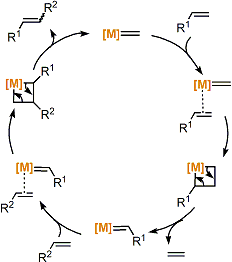
-
Examples
There are no other catalysts developed after the 90’s that are used as widely as the metathesis catalysts. Vast numbers of application are known in virtually all research areas. Interested visitors are recommended to check out the references for more detailed information.
RCM became a standard method to synthesize macrocyclic compounds, providing an alternative strategy to other macrolactonization methods. In effect, metathesis changed the way retrosynthetic analyses are done. Unlike conventional cyclization methods, the strength of metathesis is that it is capable of reacting in tandem fashion to construct a multi-ring system at once.
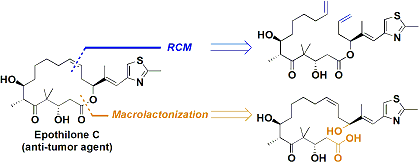
The metathesis catalysts have been influential in polymer chemistry too, thanks to their high functional group tolerance enabling the synthesis of polyfunctionalized polymers that had been difficult to synthesize. Likewise, a new class of polymers called cyclic polymers has been explored using metathesis.
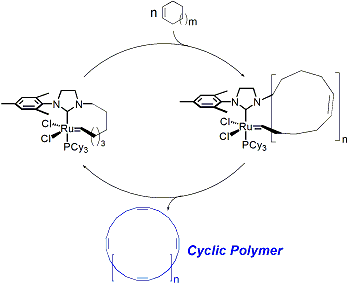
The structurally fine-tuned Hoveyda-Grubbs catalyst is active enough to be used for the synthesis of tetrasubstituted olefins, which had been feasible only by the Schrock catalyst.[1]

An example where ROM is followed by the Cope rearrangement of divinylcyclobutane to synthesize a bicyclic skeleton.

An application to the total synthesis of gambierol.
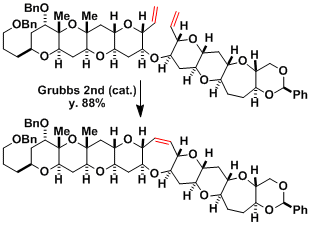
Highly active asymmetric RCM catalyst.[2]
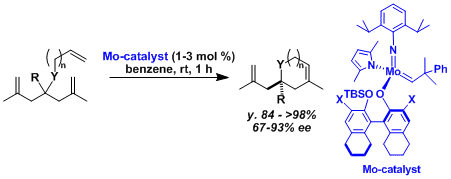
Z-Selective olefin metathesis catalyst.[3]
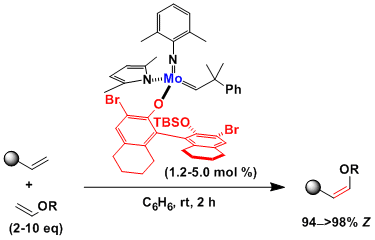
-
Experimental Procedure
-
Experimental Tips
-There is a blog website called All Things Metathesis, which is operated by the metathesis-specialized venture company Materia founded by Grubbs. The website offers useful information including nicely summarized characteristics of catalysts and reactions and is recommended to all who are interested.
-The Grubbs catalyst is stable enough to be weighed in open air but once it is in a solution it is sensitive to the dissolved oxygen. The use of degassed solvent is recommended to ensure high yield.
-
References
[1] Stewart,I.; Ung, T.; Pletnev, A. A.; Berlin, J. A.; Grubbs, R. H.; Schrodi, Y. Org. Lett. 2007, 9, 1589. DOI:10.1021/ol0705144
[2] Malcolmson, S. J.; Meek, S. J.; Sattely, E. S.; Schrock, R. R.; Hoveyda, A. H. Nature 2008, doi:10.1038/nature07594
[3] Meek, S. J.; O’Brien, R. V.; Llaveria, J.; Schrock, R. R.; Hoveyda, A. H. Nature 2011, 471, 461. doi:10.1038/nature09957
-
Related Books
[amazonjs asin=”3527324402″ locale=”US” title=”Metathesis in Natural Product Synthesis: Strategies, Substrates and Catalysts”]
[amazonjs asin=”3527306161″ locale=”US” title=”Handbook of Metathesis”]
[amazonjs asin=”354023358X” locale=”US” title=”Metathesis Polymerization (Advances in Polymer Science)”]
[amazonjs asin=”3527306927″ locale=”US” title=”Ruthenium in Organic Synthesis”]

